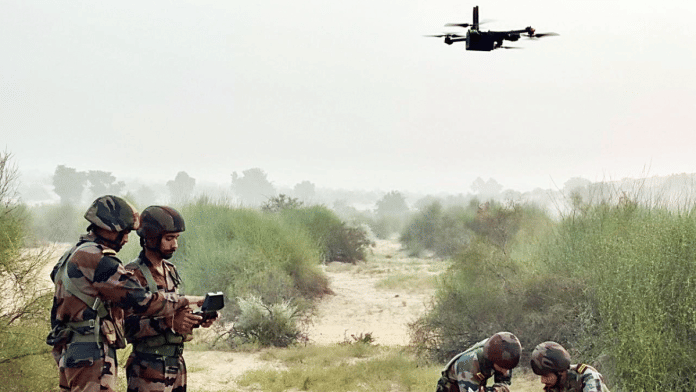New Delhi: Given the widespread use of drones, a framework is being finalised to check Chinese imprint on these platforms as well as to boost indigenisation for the purpose of national security.
Chinese components in drones—even those supplied to the Indian Army with many meant for deployment in border areas in northern and eastern sectors—have been a cause of concern for the defence establishment.
Last year, intelligence agencies had flagged the presence of Chinese components, including electrical, in drones purchased by the armed forces from domestic private players. What made the situation delicate was the Army relying on self-certification by drone makers claiming their products were free of Chinese components.
Director General, Army Design Bureau, Major General C.S.Mann said that there were 840 drone companies in the country, but they were mainly integrators. There were very few companies, which could be counted on fingers, that were actually drone manufacturers, he added.
“What we need is indigenisation,” he said at ‘Bharat Drone Manthan 2.0’ in Delhi.
The need for self-reliance, Major General Mann asserted, was felt in the past more than three years.
Elaborating the threat dimension posed by the Chinese components, the major general said that it was now a security challenge.
“But now the dimension is different. It is no more just for the purpose of supply chain resilience or no more a logistical challenge. It is a national security challenge today. Because if we have the components coming from China, they are being used in these drones and then the entire data, the control of these drones is very much in the hands of the adversary sitting over there,” he said.
“Can you imagine the amount of vulnerability we have with all these drones operating in the country? So that is what we are targeting now and I am sure the drone industry is aware of it.”
The Indian Army has had multiple iterations with the drone industry as well as other government agencies including Quality Council of India (QCI), Standard Testing and Quality Certification (STQC), and various other ministries, he said. “We (Army and the Union govt) have come up with a framework.”
Major General Mann said that such a framework could mitigate the security vulnerabilities in drones for defence, and added that it is likely to get approved very soon.
“It has already been presented to the defence secretary. It’s going to get implemented in a few months. I can say, it is just one of our steps so that we ensure that at least we don’t have vulnerabilities,” he said.
The Army, he said, was restricted to just this for now because the levels of indigenisation in the country were still maturing, or not at par with others.
“Semi-conductors and the fabrication alongside other capabilities are not there. So while the efforts and initiatives have been taken by the government, it will take some time for it to actually get established and develop that kind of capability,” he said.
The concept of manned-unmanned teams because of drones has now even graduated to the unmanned-unmanned teams, he said. A recent example of this was seen in Ukraine wherein drones and unmanned ground vehicles were being used in conjunction with each other for an operation, he added.
Explaining the Indian Army’s approach in this regard, Major General Mann said that the Army’s approach is “eagle on every soldier’s shoulder”.
“The Indian Army is looking at the idea of one drone with every soldier for the purpose of Intelligence, Surveillance and Reconnaissance (ISR) and even for the purpose of targeting,” he said. “And towards that, we’re looking at establishing drone labs even at the formation levels and also having drone incubation hubs in some of the military stations.”
It was important for India to have both drone and counter-drone measures, he said.
“So it’s a great opportunity for the industry. The global market says that the Compound Annual Growth Rate for the drone industry is nearly about 8 percent. And for the Indian market, the expectation is about $11.8 billion by 2026.”
“So, in the interim is this that at least if we can mitigate these security vulnerabilities, that will be good enough for us. But ultimately, the aim is indigenisation,” Major General Mann said.
(Edited by Tony Rai)
Also Read: Drone Federation India chief slams Rahul Gandhi’s criticism of India’s drone tech as ‘demotivating’






